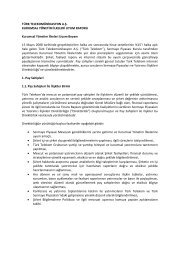PDF (3,0MB) - Türk Telekom Investor Relations
PDF (3,0MB) - Türk Telekom Investor Relations
PDF (3,0MB) - Türk Telekom Investor Relations
You also want an ePaper? Increase the reach of your titles
YUMPU automatically turns print PDFs into web optimized ePapers that Google loves.
Activities 2012In 2012, Turkey achieved to obtain a moderate growth ratein line with the implemented economy policies.Ekonomic OutlookGlobal Economic Risks Prevailed in 2012Even though four years have passed since the onsetof the global financial crisis in 2008, prevailing risksregarding the global economic outlook remain yet to bealleviated.Generally speaking, the economic outlook in 2012 wasshaped by the European debt crisis while towards the endof the year concerns over the US debt ceiling took over.European decision-making authorities lagging behindin taking concrete steps affected the global economicoutlook and international markets negatively.This situation required developed economies to givepriority to rebuilding credibility and restructuring theirfinance sectors. Throughout 2012, developed economiesfocused on taking the necessary steps to enhancethe credibility of their monetary, fiscal, and economicpolicies, to alleviate structural imbalances, and torevitalize their economies.As for developing economies, their main struggle wasimplementing the optimal and most effective monetary,fiscal, and macro-prudential policies against thechallenges and risks that were brought along by theaforementioned global conjuncture.Turkish Economy Experienced a Rebalancing Processin 2012Given the effective monetary policies implemented by theCentral Bank along with low inflation, a maintained fiscaldiscipline, a lower debt burden, the significant decreasein the current account deficit, a healthy finance sector,and continued political stability, 2012 was a year full ofsuccess for the Turkish economy. Turkey managed torecord a moderate growth rate in conjunction with thesoft-landing scenario.A strong performance in exports against the slowdown indomestic demand points to the rebalancing process in theeconomy. Even though it remained below expectations,the largely export-oriented 2012 growth rate of 2.2%could be described as a positive development in terms ofthe effectiveness of implemented policies. It is envisagedthat the positive reflection of the Central Bank’saccommodative monetary policy implemented since midyearwill become more discernible, and the contributionof domestic demand to production and growth willincrease in the period ahead. Within this framework, aGDP growth rate of around 4% is projected for 2013.Employment was Shaped by Domestic DemandThroughout 2012, prevailing uncertainties regarding theglobal economy continued to pose risks to employmentgrowth. Moreover, weak domestic economic activityand the outlook for economic growth also exertedupward pressure on the unemployment rate. The 2013unemployment rate forecast presented at the Medium-Term Program (MTP) stands at 8.9%, slightly lowerthan 2012’s rate of 9.2%. Developments, both globaland domestic, will remain as the key factors shaping theemployment outlook in 2013.Moderate Inflation was RecordedAfter hovering at the 10% to 11% level during the firstfour months of the year, inflation retreated to 8.3% inMay. During the following four-month period, inflationfluctuated around 8% to 9% and then eased down to6.2% in the final quarter of the year owing to favorableunprocessed food prices. The Central Bank announcedthat 2013 year-end inflation is estimated to be between3.9% and 6.7% (with a mid-point of 5.3%). Domesticand external demand, the performance of the TurkishLira, and the course in administered prices as well as thecourse in energy and commodity prices will be key factorsin 2013.Monetary Policy Supported the Real EconomyThe Central Bank, in view of achieving price stability,sustained its tight liquidity policy in the first half of theyear. As inflation retreated, monetary policy graduallybecame more and more accommodative in the secondhalf of the year. With the implemented expansionaryliquidity policy, short-term interest rates movedcloser to the lower limit of the interest rate corridor.After September, decisions taken by the EuropeanCentral Bank, which reduced global risks, along withmore effective implementation of the Reserve OptionMechanism (ROM), facilitated a gradual lowering in theupper limit of the interest rate corridor.In December, with the aim of containing financial stabilityrisks posed by accelerating capital inflows, the CentralBank slightly reduced the policy rate while modestlytightening reserve requirements.In 2013, the Central Bank will continue to implementmonetary policies designed to maintain price stabilityas well as financial stability. In this regard, instrumentssuch as the policy rate, interest rate corridor, liquiditymanagement, reserve requirements, leverage-basedreserve requirements, and Reserve Option Mechanismwill be deployed.50TÜRK TELEKOM ANNUAL REPORT 2012










